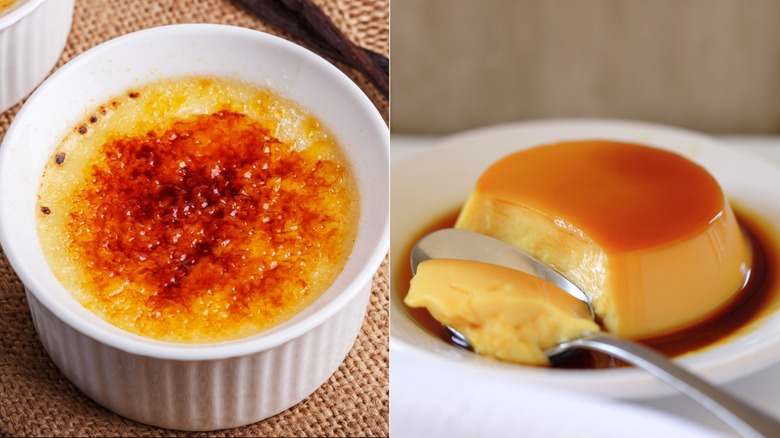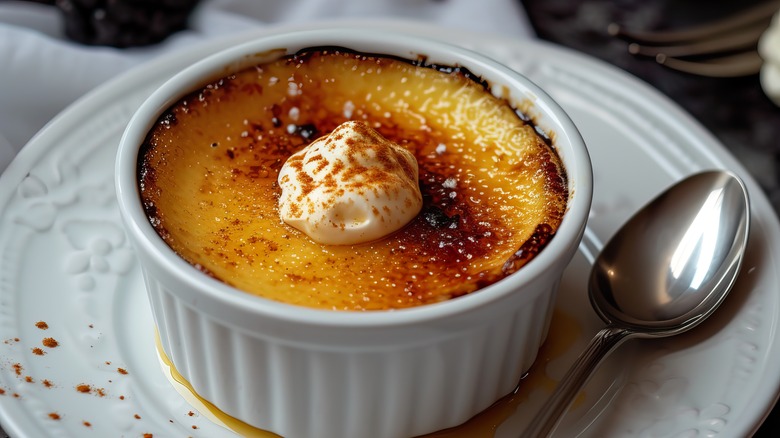What Makes Flan Different From Crème Brûlée?
Few desserts are as luxurious as custard. With a creamy, silken texture and rich sweetness, custard can be found in many forms, but its most familiar are crème brûlée and flan. However, the differences between these two sweet dishes can be confusing if you've never made them yourself or don't eat either regularly. After all, they're both basically just fancy custards, right? Well, technically, although the two have some significant differences that make them very distinct desserts.
When presented with both flan and crème brûlée, the first difference is in presentation and toppings — the things easiest to see. Crème brûlée is notable for its hard caramelized sugar crust, while flan is known for being drenched in a thin caramel sauce. However, these desserts also differ in the ratio of ingredients used to create them and how they're prepared. While both consist of a combination of eggs, dairy, and sugar, crème brûlée is usually only made with egg yolks, making it creamier and less firm than flan, which contains egg whites and is notably more stiff and jiggly, sometimes due to the addition of gelatin.
In terms of preparation, both are cooked in a water bath. However, flan typically takes longer, because it requires creating a caramel coating and a long period of cooling before being served. In contrast, once crème brûlée is cooked, it only needs to be cooled for about 30 minutes before the sugar is added and browned. Moreover, crème brûlée is served in the ramekin it's baked in, while flan is flipped onto a plate or bowl so the caramel sauce it's cooked in covers it.
Where does crème brûlée come from?
The origins of crème brûlée are debated, with England, Spain, and France all claiming that it hails from their nations. However, the earliest mention of crème brûlée can be found in "Le Cuisinier Royal et Bourgeois," a 17th-century French cookbook by Francios Massialot. Though, at that point, the dessert didn't feature its signature burned sugar topping.
Despite its inclusion in a French cookbook, Trinity College in Cambridge, England, touts that the dessert originated there when the college crest was seared into sugar-topped custard. Likewise, Catalans in Spain claim the dessert crema catalana, a custard flavored with cinnamon and citrus and topped with caramelized sugar, is the original version of crème brûlée. Whatever the truth, versions of it became popular throughout Europe until crème brûlée eventually crossed the Atlantic, with reports of Thomas Jefferson eating it at the White House during his presidency.
Since then, crème brûlée has become known as an upscale treat, a symbol of decadence, and a dessert you shouldn't pass up when in Paris. Of course, crème brûlée doesn't have to be fancy. In fact, instead of serving it in a plain ramekin, you can serve crème brûlée in a sweet potato or flip the script entirely by adding corn to the custard for a unique buttery flavor. You can also find pre-made versions at grocery stores, including Aldi, though nothing beats the taste of fresh torched sugar.
Unlike crème brûlée, flan has ancient origins
While crème brûlée was first created relatively recently, flan dates all the way back to the Roman Empire when ancient Romans mixed cream and eggs to create what they called tyropatinam, a dessert sweetened with honey and heated until stiff. That said, they also perfected a savory type of flan, like eel flan, which was served as main courses, not desserts. Following the fall of the Roman Empire, recipes for a flat cake called flado with a caramel topping circulated in Medieval Europe as versions of this custard spread far and wide, eventually to the Americas due to its popularity in Spain.
Since then, flan has become incredibly popular in Latin America, where vanilla was added. Today, you'll be hard-pressed to find a Mexican restaurant in the U.S. that doesn't have flan on the menu. The dessert is standardly served with caramel made by melting sugar or dulce de leche.
One thing that really separates flan from crème brûlée is the sheer number of varieties you can find it in. While crème brûlée can come in other flavors, vanilla is the most common; some varieties even switch up the topping instead of the custard itself. Flan, on the other hand, can be made in orange, chocolate, coffee, coconut, strawberry, and even pumpkin flavors! While savory flans aren't as popular today as in Ancient Rome and the Middle Ages, their influence can still be seen in dishes like quiche, where eggs and cream are combined with veggies and meat, usually in a pastry crust.


